During late summer we focus our attention away from the garden, and toward storing some of the harvest for the winter months ahead. We love tomatillos (toe-ma-tee-ohs), but until this spring we hadn’t grown our own here. We don’t see them for sale very often at the local Farmer’s Market, not in any quantity, and the tomatillos in grocery stores often appear to be well past their prime.
While planning the gardens for this year though we decided to try growing tomatillos (Physalis philadelphica) in our own garden for a change.
We purchased Tomatillo Verde seeds from Baker Creek early in the spring, starting them indoors at the same time we started the tomato seeds in mid-February, and transplanted the seedlings out into the gardens in mid-April. Tomatillos like similar conditions to tomatoes in the garden, except they will set fruit at cooler temperatures, and this summer, with our persistently cool weather, they have far out-performed our tomatoes.

By mid spring the plants quickly dwarfed other plants around them, and started to produce numerous nectar rich blooms for the bees
Much to our surprise, and the delight of our honey bees, the plants rapidly grew to more than 6 feet in height, and put on a profusion of flowers by late spring. Unlike tomatoes, which the honey bees rarely visit, the tomatillo blossoms were so covered in bees, that at times it was difficult to see the flowers.
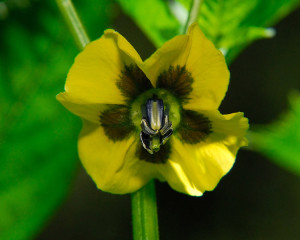
Tomatillo flowers and fruits are remarkably ornamental in appearance, and an attractive addition to the vegetable garden
That of course translated into a bumper crop of fruits!
When growing your own tomatillos, ideally they should be harvested when the fruits just fill their papery lantern-like husk, but the fruits are still green in color.
Tomatillos lose some of their sweet flavor when allowed to grow too large, so smaller fruits, that are green in color, will result in a more tart and tangy salsa. Yellow fruits tend to lose their crisp, acidic tartness, and are not ideal for salsa. The papery husks surrounding the fruits should be light brown when harvesting, and often, barely touching the fruits at this stage will cause them to fall from the plants, directly into your hand.
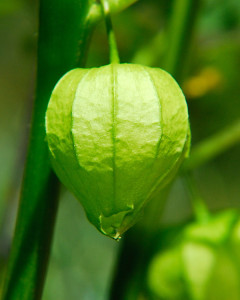
The lantern-like fruits are quite charming, and almost worth growing just for their ornamental, and bee-value in the garden.
We harvested our tomatillos over the period of a couple of weeks. While waiting to process them we simply stored them on the kitchen counter. They can also be stored in the refrigerator in plastic bags, with their husks removed, to prolong their shelf life.
This weekend we used some of our harvest to make our own homegrown Tomatillo Salsa Verde. Over the coming year, having a few jars on hand will ensure we always have salsa handy to pair with chicken, fish, soft tacos, enchiladas, burritos, even over omelets.
If you have a bumper crop of tomatillos, the following recipe can easily be doubled.
Yield: 7-8 half-pint (8fl oz/250 ml) jars
Ingredients
4 lbs Tomatillos, husks removed, and washed
10 Whole Garlic Cloves, peeled
6 Fresh Jalapeño Peppers*, seeded if desired
2 Fresh Anaheim Chiles, seeded if desired
4 Tbsp Extra Virgin Olive Oil
3-1/2 fl oz Lemon Juice, fresh squeezed
12 Scallions, sliced
1-1/2 Cups Cilantro, finely chopped
1-1/2 Tsp Kosher Salt
1/2 Tsp Black Pepper, fresh ground
Directions
Quarter the tomatillos, and place on two shallow half-sheet baking pans. Use a pan with sides, as the tomatillos will exude juice while they cook.
Add the fresh whole garlic cloves, and sliced peppers to the tomatillos, and drizzle each pan with 2 Tbsp of olive oil.
Roast the tomatillo mixture for 15-20 minutes until golden, either in an oven, or as we did, on the grill, at 450 F.
Once softened, and the tomatillos and peppers have a little color, allow the tomatillo mixture to cool slightly and then place the mixture into a food processor. Add the lemon juice, sliced scallions, and cilantro, and pulse until evenly blended, and no large chunks remain.
A stick blender also works well.
Pour the grilled, pureed, tomatillo mixture into a large non-reactive saucepan. Add the salt, and pepper to taste, and set over medium heat, stirring occasionally for 10-15 minutes until heated through. Taste and adjust the seasoning as necessary.
Have 8 hot, sterilized jars and their lids ready (see video below for tips on preparing your jars for canning).
Ladle the hot salsa verde into the jars, leaving 1/4 inch of head-space in each jar. Remove any air bubbles, and if necessary, wipe the rims clean and seal tightly with lids and bands.
Process the sealed jars for 15 minutes in a boiling-water bath. The sealed jars can be stored in a cool and dark place for up to 12 months. If the seal failed during processing, store the jar in the refrigerator for up to 14 days.
*To reduce the heat intensity of the jalapeño peppers, split the peppers length-wise, and remove the white pith and seeds before roasting. This will result in a more mild, but flavorful salsa.
————————
The following helpful video demonstrates the boiling-water bath canning technique, including basic required equipment, and how to prepare your jars and lids for canning:
Visit the National Center for Home Food Preservation for more helpful information on canning home produce.

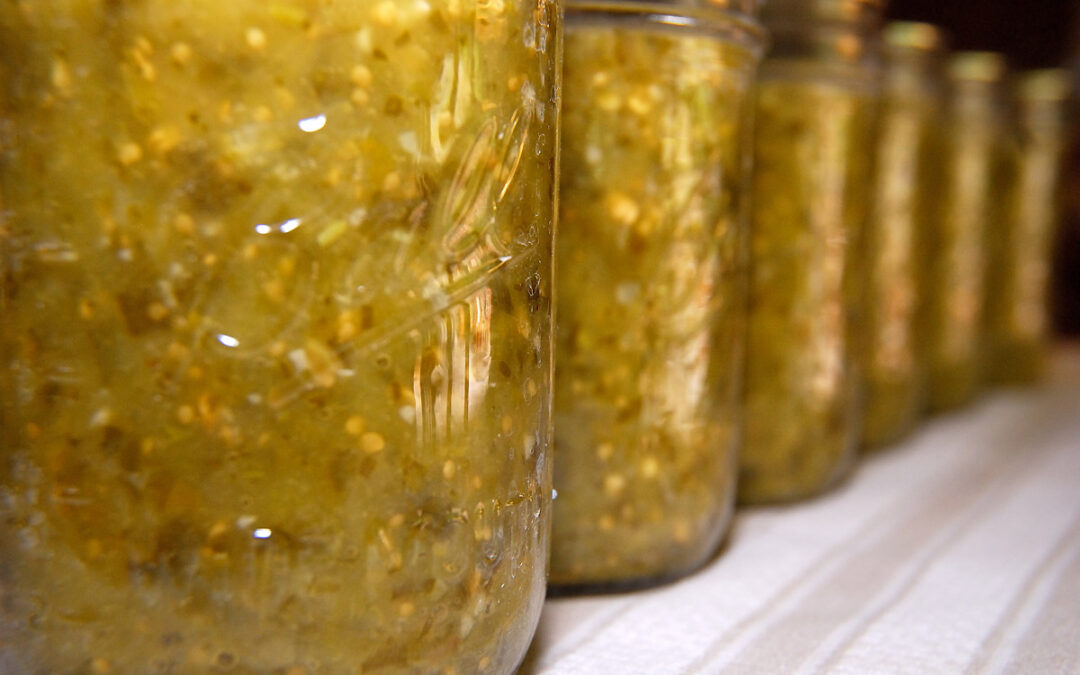
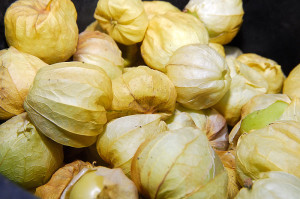

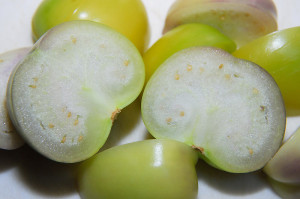
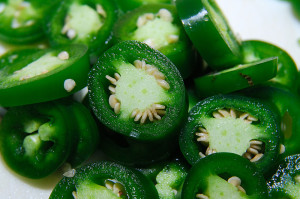

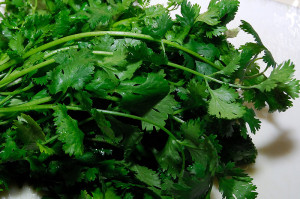

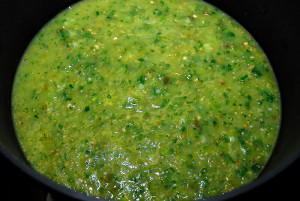
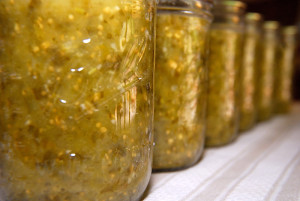







I have never grown these but love to eat them. I might give them a try next summer…looks yummy
They were fun, and very rewarding to grow. I should mention though that tomatillos are considered self incompatible, so you’ll need a minimum of 2 plants to ensure pollination.
Yum! I haven’t made any this year, but you’ve reminded me to go pick. We planted a couple kinds of tomatillos one year, and have never had to replant – they volunteer like crazy for us, so I just thin them out in the spring and leave the well-placed ones. Ours have never reached six feet, though! You must have a fabulous crop. I like your roasting method, which has one less step than our usual recipe, and sounds very delicious indeed.
Uh oh, with the squirrels distributing a few of these around the garden, I’m wondering now where they may pop up next spring 😛 That’s ok though, they’ll be in the company of the rogue volunteer tomatoes and squash that invariably crop up each year in unexpected places! I was shocked at how tall these plants got, I only expected them to be a few feet tall. Must be a testament to our soil amendments last winter!
Just like Donna, I have not planted tomatillos in my garden yet but I have harvested so many of them from my friend’s garden. Now that I’ve read your post I feel more confident in canning Salsa Verde. Need to go visit my friend’s garden again soon!
The truth is, these are so prolific, planting them in one garden would probably be enough to keep a whole block in tomatillos for the season 😉 You’re lucky to have a nice neighbor who is willing to share!
This looks so yummy! I have not attempted to grow tomatillas, but I have often given it some thought. Reading how you grew your crop has inspired me to try. Do you think they would be a better spring or fall crop versus a summer crop since they prefer somewhat cooler conditions?
They do like some heat, just like tomatoes, so it’s best to plant them out as soon as the danger of frost has passed in spring. They take a long time to mature (we transplanted ours in mid-April, and harvest started the last week of August). The difference is that tomatoes can’t tolerate low evening temperatures, as it inhibits fruit set. That happened to us this year as our temperatures here at night routinely dropped below 50F. The tomatoes bloomed, but set little fruit. Tomatillos seem to be able to take some chill, and still set fruit, thankfully! They will take up a little space in the summer garden, but it’s very rewarding when the yields are so high in return!
I’ve never grown them before either, and don’t think I’ve ever even tasted them. I can see I’ll have to rectify this and try growing tomatillos next year.
There are a couple of different varieties to try. Next year we might try the purple variety too, just for fun! They do have a unique flavor, sort of like a lemony, slightly acidic green tomato, but I’d liken the texture, at least raw, to be closer to an eggplant than a tomato. They really have to be tasted, it’s difficult to describe 😉
That looks delicious! I make a tomatillo sauce too but I hadn’t thought to roast the jalapenos along with the tomatillos. Great idea…I’ll give that a try next time!
Roasting the peppers, garlic and tomatillos I think makes for a slightly sweeter, slightly milder salsa. It’s very tasty!
Wow! This looks fantastic, Clare. I have never made salsa verde, but I’d like to grow tomatillos so I can do. Interesting that the bees like tomatillos but not tomatoes. Is it because they are in the nightshade family I wonder?
I’m growing my first tomatoes and hot peppers for the first time in a long time,…just a few without the deer fence yet. Fun!
Are these bothered by gophers or voles?
I think for the bees, tomato flowers aren’t a very good shape for them to forage nectar from. I do occasionally see a honey bee on a tomato blossom, but it’s relatively rare, and I’m presuming they’re mostly looking for pollen. I see more native bees, like our mining bees, on those flowers. The tomatillo flowers though are wide open little umbrellas, and their nectar rich flowers are very easily accessed by honey bees. We had the tomatillos right next to the tomatoes this year, so it was really noticeable how much the tomatillo blooms were preferred. As for gophers and voles, I suspect voles could be an issue, but ours were too busy eating the tomato stems 😉 We did grow our tomatillos in lined beds though, and that at seemed to keep the gophers at bay.
That sauce looks great! I have never tried tomatillos, but your post makes me want to! Nice that the bees like the flower so well.
Honestly I would grow these just for the bees, and how pretty the flowers and little lanterns look on the plants. Most vegetables aren’t particularly pretty, but tomatillos were actually a lot of fun to have in the garden this year.
Clare, your recipe looks good, although I never had a tomatillo. Something new to try.
You have to try them. Maybe next year see if you can squeeze in a couple of plants. Just brace yourself for a lot of fruit if they’re happy where you plant them! 😉
I have never grown or eaten tomatillos. If they like cooler summers, I think they may have a hard time growing for me. However, the recipe looks great! I wonder if I could adapt it using regular tomatoes? Thanks, too, for the video on water bath canning!
I suspect they may do well where you are. They put up with the cooler weather better than tomatoes, although I’m not sure they really demand it, they’re just more forgiving. They’re generally very disease and pest resistant too. No aphids, no grasshopper damage, and even somewhat drought tolerant too.
You’d have to be careful adapting this recipe for use with tomatoes. Tomatoes aren’t acidic enough to be canned using a water bath canner (tomatoes usually require the use of a pressure canner to prevent botulism). However, you could cut the recipe in half, or quarters, and perhaps just make a fresh refrigerator salsa with the same ingredients. I just wouldn’t make so much that you can’t use it within 7 days…just to be safe.
Sold! I’ve never (knowingly) eaten a tomatillo, but they have always looked interesting, and the good fruiting in cooler summers is very appealing. I shall bookmark this for when I get to try growing them myself. Thank you!
I expect you’d remember them if you’d eaten one. In California it’s difficult to avoid eating them in some restaurants. Your climate isn’t much different to our coastal climate here, so I expected they’d grow well for you.
I didn’t plant them this year, but they volunteered on their own so I have a bazillion. (May be a bit of exaggeration.) I’ll try your recipe!
Now I’m getting nervous. Between the experiences of you and Zoe, it seems we should expect a healthy crop of volunteer tomatillos in the garden next spring. I need to talk to the squirrels and ask them to plant them somewhere sensible 😛
Alas! I can no longer eat these, thanks to my nightshade allergies.
I planted these one summer in upstate New York, and the came back summer after summer. They pretty much stayed in the original garden bed. I loved ’em!
I forgot about your nightshade allergy. Darn solanine, that really puts a lot of veggies on your no-go list 🙁 I’m not sure what I’d do if I couldn’t eat tomatoes, peppers, and potatoes. Just promise me you won’t develop an allergy to honey!
I have to confess to not knowing Tomatillos at all. I don’t know if we even get them here in South Africa – I’ve never noticed them and don’t think I’ve ever eaten one. I’ll have to look out for them at the nursery. Your recipe looks great.